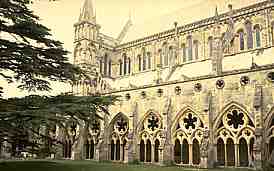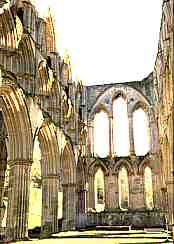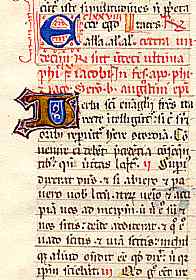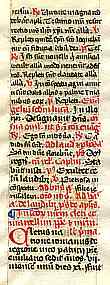 |
| The Breviary |
| In the later middle ages, the breviary was the book which contained all the texts and music for the celebration of the divine office. The practice of this liturgy at the eight canonical hours was established in the Benedictine Rule, and the huge choirs of the mighty monastic churches, such as that of the Cistercian Abbey of Rievaulx illustrated at right, testify to the significance of this aspect of monastic work, as this was where both the divine office and the mass were celebrated. Like the missal, the breviary was a text which was gradually compiled from its components over time, appearing in complete form in the late 11th century, but not appearing outside Benedictine circles until the early 13th century. |
|
Interior of the ruined choir of Rievaulx Abbey, a Cistercian house in Yorkshire. |
| The heart and soul of the breviary was the psalter, as the heart and soul of the divine office was the chanting of the Psalms at the specified hours of Matins, Lauds, Prime, Terce, Sext, None, Vespers and Compline. The very early practice of attempting to recite the entire psalter daily proved to be impossible, so the Psalms were divided into sets to be chanted at particular times. Over time, the elaboration of the offices required a library of liturgical books to provide the texts of the various components of the office. The earliest books identified with the name breviary, from the 8th century, were, in fact abbreviated forms of these texts, using incipits and rubrics to identify passages; more of an index than a complete text. The final evolved form of the breviary included the complete text of all the components of the office for each of the specified hours, for each season of the year, and including variants and special texts for the many church festivals. It was a huge and complex work. |
|
The breviary was even more complex than the missal, because it contained not only all the variant texts of the components of the divine office for ordinary days, Sundays and the various feasts of the church calendar, with variations for the different seasons of the year, but also separate texts for each office in the daily round. It was really a complex hypertext document which required considerable knowledge to even navigate around it to find the appropriate texts for each day of the year. While it theoretically contained the complete text for every occasion, sheer size meant that it was highly abbreviated, and often written in a tight compressed form. Apart from rubrics and some fancy initials to aid in navigating the text, breviaries did not tend to be highly decorated. The example at left shows the beginning of a reading from St Augustine for the feast of the apostles Philip and James. |
| Segment from a page of a 15th century Carthusian breviary from Spain, from a private collection. |
| A nice example of hyperabbreviation in the above example is near the top, to the bottom right of the initial E, where it says alla al al cetera undecim. I am not sure whether that means alleluia 11 times or 33. |
| The sheer density of information meant that the breviary was not a lectern book. Presumably they were held for reference, and larger format works containing the various components were actually used by the monks in the choir, as well as their prodigious memories. The works were written out in double columns, and the script could be a tiny glossing script of the type used in portable Bibles. The example at right is a single column from a page of a breviary produced for Augustinian hermits. (I thought that Augustinian and hermits would have been mutually exclusive terms, but my resident medievalist assures me that they did exist.) The total page size is about 8 x 11 cm, with the written area around 5 x 7 cm. The column shown is about 2 x 7 cm, and I cannot read it without a magnifying glass. There is no way that some old Augustinian hermit would be reading it by flickering candlelight in a freezing church at Matins in winter. This was a book for the library. |
|
| Column from a late 14th century breviary from southern France, for Augustinian hermits, from a private collection. |
| The fact that the book was inevitably in Latin, the language of liturgy, and was immensely complex to navigate, means that it was a book for the clergy, not the laity. There are some examples known of breviaries commisioned by aristocratic patrons for their personal ownership. These were fancy illuminated volumes, like their psalters and books of romance, and could be considered to be prestige items. However, they were most unlikely to be taking these to church for their private use. More likely they would have been used by their private chaplains, and then only on special occasions, perhaps if the Duc de Berry was coming around for lunch and they wanted to impress him. The very much simpler and more personal book of hours became the means by which the laity observed a simplified form of the divine office in their private lives. However, there is some overlap between the content of some of the more elaborate psalters, particularly those in private ownership, the book of hours and the breviary. |
 |
The cloister of Salisbury Cathedral, because that is where the use of Sarum originated, and besides it looks pretty. |
| The texts for the various components of the breviary were drawn from a limited range of approved sources, mainly the Bible, but also the patristic writings of the fathers of the church. However, the scheme was not absolute for all of western Christendom and, like the mass, the office was different in the various provinces, or archdioceses, and could even differ between dioceses. This is referred to as the use, so use of Rome, use of Utrecht, use of Paris or use of Sarum identifies the particular formulation of the office in a breviary. Local inclusions sometimes appeared that were not approved, such as apocryphal or legendary material or prayers to unofficial local saints. Crossing these geographical boundaries, certain orders had their own uses. The Cluniacs were famed for their highly elaborate liturgy and spent even more time than the average Benedictine community in celebrating the divine office. The appearance of the hardworking friars, busy in their pastoral duties, led to the need for a more simplified office and a more portable breviary. The form of the breviary produced by the Franciscans became steadily more widespread. |
|
 Categories
of Works Categories
of Works |
|
 |
 |
 |
 |
 |



